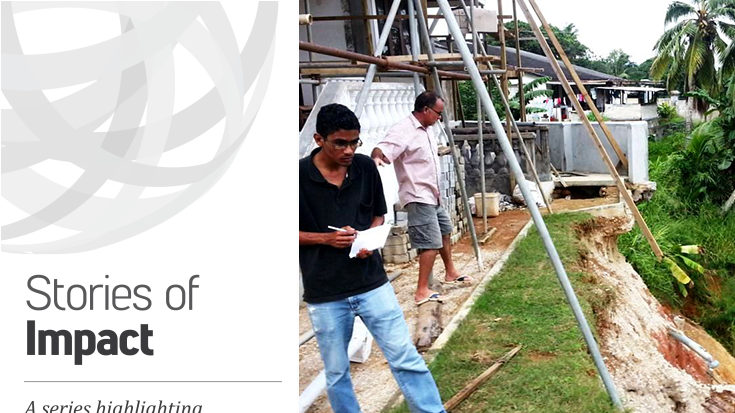REGION: AFRICA
COUNTRY: SEYCHELLES
FOCUS AREA: RESILIENT RECOVERY
Results & Achievements
- The government of Seychelles has developed short, medium, and long-term disaster resilient development initiatives which are expected to benefit 87,000 people, and rehabilitate and protect 500 kilometers of roadways from disasters.
- A Damage and Loss Assessment laid the foundation for the creation of Sub-Saharan Africa's first World Bank-financed disaster contingent credit line, which provides the government with $7 million in immediate liquidity in the aftermath of a large-scale catastrophe.
- As a result of the extensive risk financing assessment, Seychelles recently joined the newly launched Southwest Indian Ocean Risk Assessment and Financing Initiative, a regional effort to increase fiscal capacity to respond to disasters.
- The results of the Damage and Loss Assessment led to the development of multi-risk mapping and an extensive review of flood risk financing options to address the $30 million estimated cost of immediate reconstruction and recovery needs.
Following repeated cyclones and heavy flooding in the Indian Ocean islands of Seychelles, the government renewed its efforts to increase resilience to natural disasters. When Tropical Cyclone Felleng battered the multi-island country with heavy rain in January 2013, the government, with support from the World Bank and the Africa Caribbean Pacific-European Union Natural Disaster Risk Reduction (ACP-EU NDRR) Program, an initiative managed by the Global Facility for Disaster Reduction and Recovery (GFDRR) worked to assess the damages and ensure that recovery efforts mitigate the effects of future natural hazards.
Seychelles, with its steep terrain and location in the Indian Ocean, is highly vulnerable to tropical cyclones, floods, storm surges, landslides and tsunamis. The risk is further exacerbated by climate change and sea-level rise. The 2013 cyclone caused flooding and landslides that led to damages and losses exceeding $8.4 million, or .77% of the country’s gross domestic product (GDP). Seychelles’ infrastructure was the heaviest hit, with many roads completely washed away by the storm.
Approach
In the wake of the disaster, the government implemented a National Flood Task Force and, with support from the World Bank Africa Disaster Risk Management Group and GFDRR through the ACP-EU NDRR Program, conducted an innovative Damage Needs and Loss Assessment to evaluate the social, economic and environmental impacts of the storm, and quantify needs to increase resilience to future disasters. To ensure that post-disaster recovery is resilient:
- The government, in coordination with United Nations (UN) agencies, the World Bank and the European Union (EU), conducted the assessment.
- World Bank experts trained key ministries in affected sectors such as infrastructure and agriculture in the assessment methodology.
- Using the results from the assessments, a disaster recovery framework on flood-risk management was proposed, providing vital recommendations on integrating flood risk management considerations at the institutional, investment and policy levels.
- The implementation of risk transfer and insurance mechanisms was recommended, sparking the launch of a similar, region-wide initiative.
Lessons Learned
Lack of compliance to building regulations increased impact of the disaster. The assessment revealed that lack of compliance and lightly enforced regulations, especially in the areas of construction and land use planning contributed to losses. Local authorities are now working to better enforce building regulations and zonal planning, and disaster-prone zones have been identified.
Working together is essential to building back better. At the time of the disaster, no standardized communication system for stakeholders was in place. It was evident that long-term disaster resilient development for disaster-prone countries can only be achieved when stakeholders collaborate in a joint effort. The government has been strengthening its partnerships with all levels of society, from the private sector to non-profit as evidenced by the implementation of the assessment, so that a comprehensive framework can be effectively implemented.
Next Steps
The assessment provided a clear understanding of damages, needs and losses within the impacted sectors. This laid the groundwork for immediate and long-term recovery and reconstruction efforts needed to withstand the negative impacts from future disasters. Medium-term and long-term goals were also established and included the relocation of key public buildings to higher ground, the preparation of an integrated national disaster risk management plan, the revision of the flood management legal framework and the development of new risk-based building codes.
